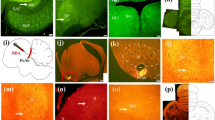Abstract
IT has been suggested that enkephalin is the endogenous ligand for the opiate receptor1–3. This substance is unevenly distributed throughout the brain3,4 and occurs as two pentapeptides—met- and leu-enkephalin5. These substances have been shown to possess analgesic activity when injected intra-cerebroventricularly into rodents6,7 and to depress the firing rate of single neurones in the brainstem of cats8 and rats9. In the present experiments the effects of synthetic metenkephalin have been compared with those of morphine on Renshaw cells in the feline spinal cord using the micro-electrophoretic technique. This cholinoceptive interneurone is particularly suitable for such a comparison since it possesses stereospecific opiate receptor sites10,11. The results obtained show that both met-enkephalin and morphine directly excite Renshaw cells and that these actions are antagonised by naloxone.
This is a preview of subscription content, access via your institution
Access options
Subscribe to this journal
Receive 51 print issues and online access
$199.00 per year
only $3.90 per issue
Buy this article
- Purchase on Springer Link
- Instant access to full article PDF
Prices may be subject to local taxes which are calculated during checkout
Similar content being viewed by others
References
Kosterlitz, H. W., and Hughes, J., Life Sci., 17, 91–96 (1975).
Terenius, L., and Wahlstrom, A., Acta physiol. scand., 94, 74–81 (1975).
Pasternak, G. W., Goodman, R., and Snyder, S. H., Life Sci., 16, 1765–1769 (1975).
Hughes, J., Brain Res., 88, 295–308 (1975).
Hughes, J., et al., Nature, 258, 577–579 (1975).
Belluzzi, J. D., et al., Nature, 260, 625–626 (1976).
Buscher, H. H., et al., Nature, 261, 423–425 (1976).
Gent, J. P., and Wolstencroft, J. H., Nature, 261, 426–427 (1976).
Bradley, P. B., Briggs, I., Gayton, R. J., and Lambert, L. A., Nature, 261, 425–426 (1976).
Davies, J., and Duggan, A. W., Nature, 250, 70–71 (1974).
Davies, J., Brain Res. (in the press).
Duggan, A. W., Davies, J., and Hall, J. G., J. Pharmac. exp. Ther., 196, 107–120 (1976).
Curtis, D. R., and Duggan, A. W., Agents Actions, 1, 14–19 (1969).
Author information
Authors and Affiliations
Rights and permissions
About this article
Cite this article
DAVIES, J., DRAY, A. Effects of enkephalin and morphine on Renshaw cells in feline spinal cord. Nature 262, 603–604 (1976). https://doi.org/10.1038/262603a0
Received:
Accepted:
Issue Date:
DOI: https://doi.org/10.1038/262603a0
This article is cited by
-
Effects of a delta opioid receptor agonist and inhibitors of enkephalin catabolism on periaqueductal gray neurons in the rat midbrain: Anin vitro study
Neurophysiology (1999)
-
Coerulospinal influence on recurrent inhibition of spinal motonuclei innervating antagonistic hindleg muscles of the cat
Pflügers Archiv - European Journal of Physiology (1988)
-
Effect of?-endorphin on unit activity in the preoptic region as the regulating center for gonadotrophic function
Bulletin of Experimental Biology and Medicine (1980)
-
Hyperpolarisation and depression of slow synaptic inhibition by enkephalin in frog sympathetic ganglion
Nature (1979)
Comments
By submitting a comment you agree to abide by our Terms and Community Guidelines. If you find something abusive or that does not comply with our terms or guidelines please flag it as inappropriate.



